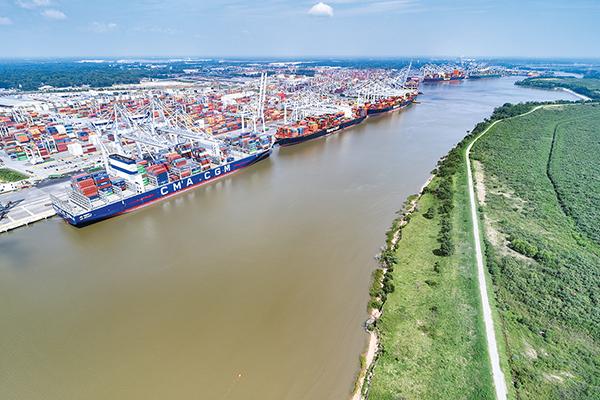
While we buy and use goods on a daily basis, few of us stop to think about the chain of events put in motion to get those goods into our homes. Before they arrived at a store or on our front porches, they probably came off a truck. Before that, they may have been on a train or an airplane. The majority of goods we use, however, probably came through a seaport or riverport.
Ports are the catalysts for the global economy. They’re more than a place where ships dock: they are sophisticated transportation hubs that facilitate the movement of raw materials, finished goods and everything in between. Most of the nation’s largest ports are as large and complex as a medium-sized city, and they have millions of moving parts that must be overseen, managed and updated. In this feature, we’ll examine some of the most important ports in the nation.
Port of Caddo-Bossier, Louisiana
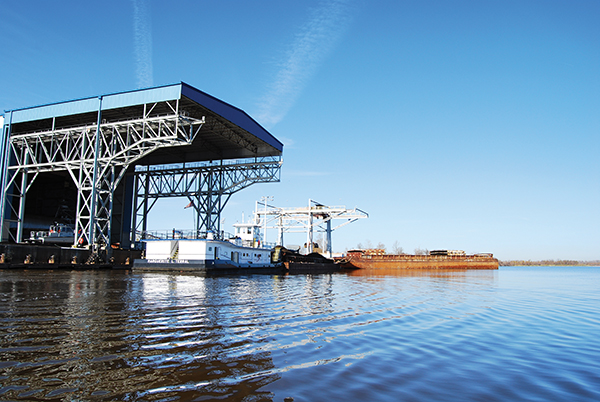
The Port of Caddo-Bossier is an industrial park and inland multi-modal transportation and distribution center located in Northwest Louisiana, about four miles south of Shreveport. It occupies 4,000 acres of land, with land available for lease, and offers easy access to I-20 and I-49, which provide east-west and north-south connections. The port also provides on-site rail with daily switching, and a foreign trade zone and U.S. Customs Port of Entry.
The port is situated at the head of navigation on the Red River Waterway, which connects to the Mississippi River and allows waterway access to northern ports and the Gulf of Mexico. It also features warehousing and transloading services. It is home to 20 national and international companies that employ more than 1,800 workers. The port serves various industries, including oil and gas, steel, paper, agriculture, manufacturing and distribution, and generates 4.1 indirect jobs for every one direct job at the port. It collaborates with all relevant governing entities and the other economic development groups to advance the region’s prosperity and competitiveness.
The Port of Caddo-Bossier continues to expand and improve its facilities to meet the needs of tenants and customers. In September 2023, the port broke ground on a new 40,000-square-foot heavy-load warehouse that will feature a 100-ton crane capacity and a 40-foot eave height to handle oversized and overweight cargo. In October, the port and Bossier City officials broke ground on a new $35 million waterline that will provide water to the port for its newly acquired expansion area and be a backup for existing port tenants.
A $4.5 million project was completed in 2023 and included three hardstands, or strong surfaces for parking heavy vehicles, machinery and inventory, enhancing the capacity and productivity of existing tenants and customers and to expand the area for transloading cargo from one mode of transportation to another. In 2022, the port welcomed a brand new tenant, Alpine Silica, and cut the ribbon on a new 100,000-square foot heavy-load warehouse.
“The Port of Caddo-Bossier is a strategic and dynamic hub for trade and commerce in Northwest Louisiana, connecting the region to the world through its multi-modal transportation and distribution capabilities,” said Executive Port Director Eric England. “The Port is committed to enhancing its facilities and services, and pursuing new opportunities and partnerships, to meet the current and future demands of its tenants and customers. The Port of Caddo-Bossier is truly a gateway to the world.”
Port of Brownsville, Texas
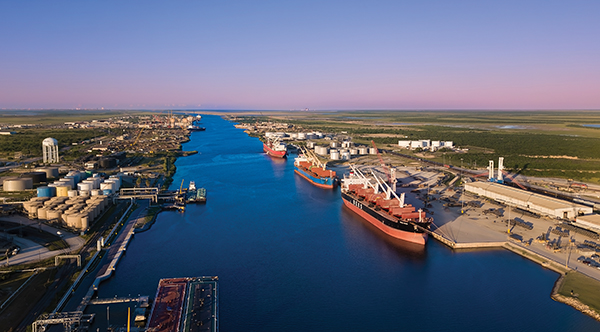
Since 1936, the Port of Brownsville has been a driving force for the Rio Grande Valley’s economy. In the last decade, the port has made significant strides. With major infrastructure improvements, increased capabilities and a strong commitment to sustainability, the Port of Brownsville serves as a symbol of progress in the maritime industry.
As the only deepwater seaport located directly on the U.S.-Mexico border, the Port of Brownsville is strategically positioned to serve and connect industries across North America and beyond. The port is a prominent shipper of steel, refined petroleum products, grain, aggregates and more.
Convenient and efficient commercial border crossings are located seven miles from the port by truck or about 13 miles by railroad at the West Rail Bridge. Class 1 rail service to and from the port to Mexico and all of North America includes Canadian Pacific Kansas City for operations south of the border, and Union Pacific and BNSF Railway serving northern routes.
In June 2023, Ternium announced it will invest $3.2 billion to build a new steelworks and cold-rolling facility at the company’s existing site in Pesquería. With multiple steel furnaces, the new facility will augment Ternium’s production capacity, enabling it to capitalize on strong international demand. This project includes the construction of a marine terminal at the Port of Brownsville to support Ternium’s facility in Mexico.
The Port of Brownsville continues to solidify its role as a critical asset and a key component of the Texas energy sector. In July, NextDecade Corp. began construction of its Rio Grande LNG plant, a major liquefied natural gas export facility. More than 5,000 jobs are projected to be created during phase one of the construction, and the project is estimated to generate an increase in gross domestic product of $6 billion in Cameron County, $23 billion in Texas and up to $35 billion in the U.S. The Rio Grande LNG terminal will consist of five trains with the capacity to export 27 million tonnes per annum (MTPA). At full scale, Rio Grande LNG will deliver enough energy to heat and cool the equivalent of nearly 34 million U.S. households annually.
Infrastructure improvements at the port continue with the Brazos Island Harbor Channel Improvement Project, which will deepen the 17-mile-long ship channel from 42 to 52 feet. A deeper ship channel will increase the navigability, facilitating the safe passage of ships and reducing transit times. These infrastructure upgrades will significantly boost the Port’s competitiveness and attract increased investments.
Georgia Ports

At Georgia Ports Authority, deepwater terminals in Savannah and Brunswick ensure the continuous flow of goods to and from global destinations. The Port of Savannah is the third busiest container gateway in the U.S., while Brunswick is poised to become the nation’s busiest hub for autos and machinery. GPA provides greater scheduling flexibility and market reach with 35 weekly containership services, direct interstate connections and on-terminal rail. GPA is investing $4.5 billion in infrastructure expansion over the next 10 years.
Container Berth 1 reopened in July with improvements, including another big ship berth that allows the Port of Savannah’s Garden City Terminal to serve additional vessels with a capacity of 16,000+ twenty-foot equivalent container units (TEUs). In addition, the Mason Mega Rail Terminal is now the largest marine terminal rail facility in North America. This $220 million facility provides 24 miles of track on 85 acres at the Port of Savannah’s Garden City Terminal. GPA’s state-of-the-art intermodal service allows ocean carriers to offer customers through-rates to more inland markets from their first port of call, streamlining the logistics process.
Going forward, the long-term storage yard will add 100 acres and one million TEUs of annual capacity adjacent to Garden City Terminal proper. The project is slated for completion by next year. Additionally, the Georgia Ports Authority Board has approved expenditure of $127 million to build the Blue Ridge Connector, an inland rail terminal in Gainesville, linking Northeast Georgia with the Port of Savannah’s 35 global container ship services.
The facility will open in 2026 and serve a region important for the production of heavy equipment, food and forest products. Finally, at the Port of Brunswick, construction is complete on 350,000 square feet of near-dock warehousing for auto and machinery processing at Colonel’s Island Terminal. Three other buildings totaling 290,000 square feet and 122 acres of roll-on/roll-off storage are under
construction.
“Over the next 10 years, our ports will play a major role in strengthening Georgia’s position as a global center for business, in part by increasing our capacity to handle additional trade,” said Griff Lynch, Georgia Ports Authority President and CEO. “By 2030, we anticipate growing our capacity from the current seven million to 10 million TEUs.”
Port of Lake Charles, Louisiana
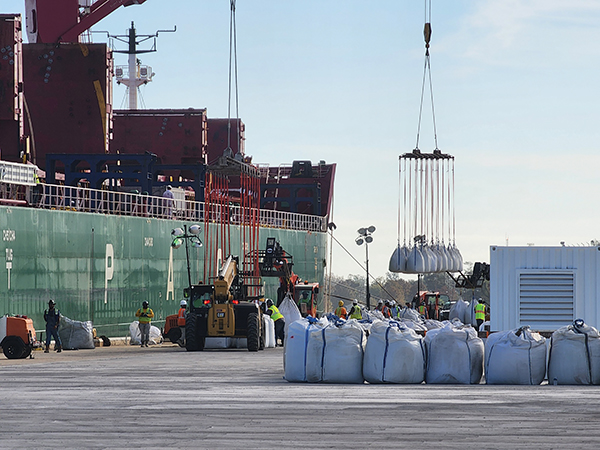
The Port of Lake Charles is a deepwater seaport in Lake Charles, Louisiana, located on the Calcasieu Ship Channel. It’s the nation’s 14th-busiest port district based on tonnage. The port manages the Calcasieu Ship Channel, which runs inland 36 miles and extends out into the Gulf of Mexico another 32 miles. The Port of Lake Charles’ official name is the Lake Charles Harbor & Terminal District, which encompasses 203 square miles. It’s a port of choice for breakbulk, specialty and project cargo, ranging from international lumber shipments to global industrial needs. It’s also part of “America’s Energy Corridor,” serving as the world’s number one LNG export area.
Marine cargo activity along the Calcasieu Ship Channel and at the Port support $39 billion of total economic value to the U.S. economy annually — and 67 percent of the Lake Charles area’s entire gross domestic product. Common cargoes include lumber, alumina hydrate, bagged cement, rough (unmilled) rice, raw coke, rutile, calcine, sodium hydrosulfide and large industrial components.
Recently, the port completed a rehabilitation project to add strength and capacity at City Docks in the area of Berths 2 and 3. In addition, an ongoing five-year capital improvement project is underway to add capability and capacity to the port district — as well as to fully recover from the record damage sustained in 2020 from Hurricane Laura, the most destructive natural disaster in Lake Charles history.
Offshore wind power may become a significant asset for the port in the future. The Port of Lake Charles is located north of a federally designated offshore wind area in the Gulf of Mexico, and its properties include inland waterways and infrastructure that could serve and wind-power manufacturing and/or handling.
“The Port and Calcasieu Ship Channel help generate fully two-thirds of the Lake Charles area’s GDP,” said Richert L. Self, Executive Director of the Port of Lake Charles. “A 2020 economic study we commissioned found that the cargo moving via the marine terminals located along the Calcasieu Ship Channel supported 158,485 jobs nationwide. Of those, 108,773 jobs are supported in Louisiana — about six percent of statewide employment — and 42,075 of them are supported in the Lake Charles MSA, which represents 45 percent of area non-farm jobs.”
Port Freeport, Texas
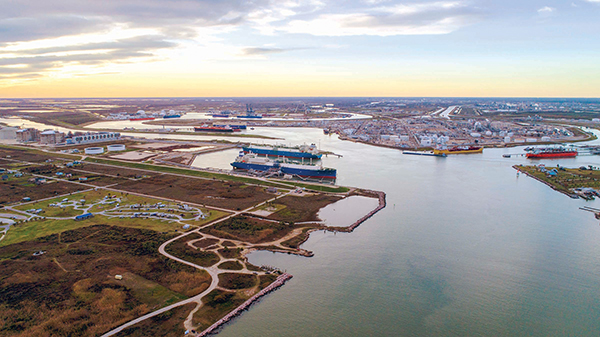
Port Freeport is located in Brazoria County, Texas, about one hour south of downtown Houston, and is a self-governing body of the State of Texas. Port Freeport is a navigation district and local sponsor of the Freeport Harbor Channel, which serves public and private facilities. In general, Port Freeport is a liquid bulk export port with private terminals capable of handling energy and petrochemical products. The port’s public facilities handle only dry goods, primarily containerized, breakbulk, bulk, project and roll-on/roll-off (RORO) cargoes. As of 2022, Port Freeport supports 109,800 direct, indirect and induced jobs statewide. In 2023, Port Freeport ranked 17th nationally for total foreign waterborne tonnage handled.
In May 2023, Port Freeport completed the extension of the berth at Velasco Container Terminal. Berth 8 added 927 feet plus an 85-foot RORO platform to the existing 800-foot Berth 7. The two existing post-panamax cranes were recently modified (electrical cables extended), and the cranes can traverse the entire 1,727-foot length of dock. The final engineering of the Port’s new Gate 12 access to Velasco Container Terminal is underway and expected to be completed in Q3 2024. Road improvements and a new truck queuing area will commence in Q1 2024 and be completed in Q4 2024. Port Freeport has been awarded more than $22 million in grant funding from the Texas Department of Transportation for improvement projects.
In September 2022, Port Freeport entered a long-term agreement with Volkswagen Group of America (VWGoa), which is building a 120-acre facility at the port. This facility will become VWGoA’s Gulf Coast hub for marine and rail import activity. In July 2023, Port Freeport entered a long-term agreement with Del Monte Fresh Produce N.A. for a retrofitting project at the Velasco Container Terminal that will include 688 plugs for refrigerated containers. In Q2 2024, Del Monte Fresh Produce will relocate its Texas port operation to Port Freeport.
Finally, in late 2023, Port Freeport executed an agreement with ZPMC to acquire two post-panamax gantry cranes, which are expected to arrive in 2025, bringing Port Freeport’s total ship-to-shore crane count to four.
“Port Freeport is a critical artery in Brazoria County for the movement of waterborne commerce,” said Jason Miura, Director of Business and Economic Development for the port. “Port Freeport continues to pursue and achieve its strategic objectives for growth, to ensure resounding positive economic impacts for the Brazosport Area, the Greater Houston Region, the State of Texas and the U.S.
Port Laredo, Texas
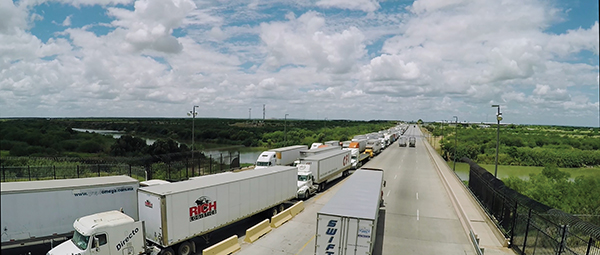
Port Laredo is now the number one commercial port in the U.S. based on total import and export value for 2023. This year, Port Laredo surpassed the Port of Los Angeles and Chicago O’Hare Airport and maintained its standing over the Port of Newark, JFK International Airport, Port of Houston, Port of New Orleans and all the other 450+ sea, land and airports. Through the first nine months of this year, the port’s trade is up eight percent over last year’s record of $299 billion.
Port Laredo consists of two commercial vehicle bridges, a rail bridge and an international airport supported by hundreds of global trade operators in the warehouse, distribution, customs brokerage and transportation industry throughout 43 million square feet of industrial space.
The vast majority of Port Laredo’s global trade (97 percent) is with Mexico due to its proximity to the border, but it sees significant trade of over $1 billion per year with China and Japan, and over $500 million with France, Nicaragua and South Korea.
The port’s optimal location at the heart of North America’s highway system connecting Mexico and the U.S., along with its global trade expertise, contributes to North American competitiveness and allows for the facilitation of nearshoring to continue to eat into the nation’s dependence on trade with China. Global supply chain dynamics have changed in the post-pandemic world as near-shoring continues to provide the region with the opportunity to capitalize on a favorable location, a pro-business climate, a young population, workforce advantages, an efficient bridge system and close public-private partnerships.
Products moving through Port Laredo include agricultural goods like avocados, tomatoes and berries; electronics, energy products, industrial equipment, protein products like pork, beef and chicken; and other goods. Laredo has been the beneficiary of many cold chain expansion projects in recent years, and there are commitments for more. These include facilities and expansions from Mission Produce, U.S. Cold Storage, Sunset Produce, Nature Fresh Farms, Cold Terminal and Librado Pina, Inc., and commitments from West Pak Avocado and Lineage Logistics for major investments.
“Just as important as our continued supply chain leadership are the successes and growing interest we are seeing as a result of our diversification efforts in the areas of manufacturing, cold storage and produce processing centers, health care services and industry, energy, destination retail/hospitality and quality of life,” according to a statement from Port Laredo. T&ID

